Table of Contents
6
Convergence of CCT
Objectives
After completing this Chapter, the student will be able to:
- identify various terms associated with convergence of CCT,
- correlate communication system and its components,
- classify components of communication system,
- explain the process of data transfer,
- compare different data communication technologies,
- justify the need of convergence of technologies to meet the next generation unified applications,
- visualise application of unified messaging system and
- appreciate the importance of standardisation of various components in any system.
“Seven hundred million people living in the rural areas need a unique rural development model called PURA (Providing Urban Amenities in Rural Areas) which envisages provision of three connectivities namely physical connectivity, electronic connectivity and knowledge connectivity leading to economic connectivity.”
Dr A.P.J. Abdul Kalam
Introduction
In the earlier chapters, we saw how computer systems have become an important tool for our day–to–day functions. Online applications as ATMs, automatic complaint registration, railway reservation, etc. have improved our productivity and made our job faster and easier. In the next chapter on ‘the Internet’, we will see that most of the current applications are Internet based and depend heavily upon the communication systems. In this chapter we shall see that the communication systems have undergone gradual changes from the telephone system to video–conferencing. Communication systems are converging to provide next generation applications (Figure 6.1).
Even before computers were invented, there were various modes of communication like postal services, telegraphs and telephones. In the twentieth century, considerable efforts were made to develop reliable and affordable telecommunication systems. Telecommunication systems were developed to effectively use multiple services such as television, radio news broadcasting, etc. along with the telephone.
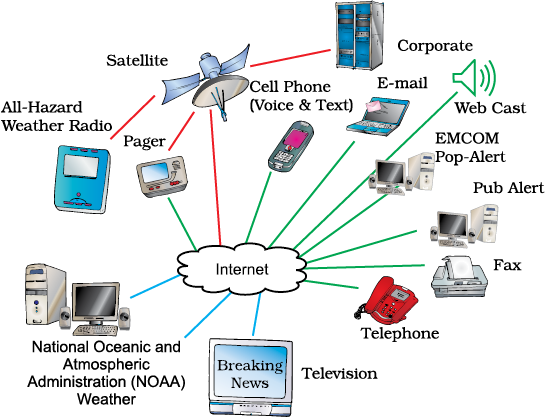
Telecommunication systems were also used for long distance communication between computers.
A revolution in the computer technology started in the middle of the twentieth century. Today the computer is not just a data processing device, if has become a multipurpose utility tool. The computer is being used, among many other things, for documentation, entertainment and communication.
Communication system is a very general term which means a combination of computers, communication devices, associated networks and required software.
Let’s consider a simple example of sending a picture to a friend using e-mail.
Traditionally the picture could be sent through the postal service. The sender would put the picture in an envelope and post it at the nearest post office. The postal service would then deliver the envelope to the receiver. The receiver could get the picture in two days or in a month or never, and it could even get lost.
Using modern communication system the picture can be sent instantly in the following way.
To send the picture, the sender would use a scanner (Figure 6.2 ) to get its copy on the computer. Then the computer has to be connected to the Internet. The sender would use an Internet application such as e-mail to attach the picture and send it to the receiver’s e-mail address.
The receiver could be located in any part of the world, s/he can receive the copy of the photograph within minutes. S/he would connect to the Internet and login to her/his e-mail account, download the picture into her/his computer system. If needed, a printer can be used to get a copy of the picture.
Similarly any information such as a document, an image or music can be instantly transferred to any part of the world using modern communication systems.
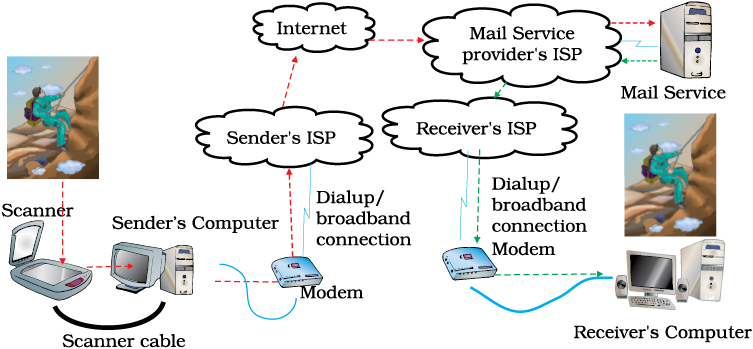
Apparently this operation may look simple, but in the background there are many interconnected devices and networks that are involved. At various stages, our data (picture) is converted into various forms until it reaches the final destination.
Any information which can be digitised, whether it is voice, data or video, can be communicated through our present day electronic communication system.
6.1 Components of Communication Systems
In a communication system there are various components which are interconnected through communication devices, networks and communication software. All communication systems have the following five essential components which interact with each other to provide seamless connectivity (Figure 6.3).
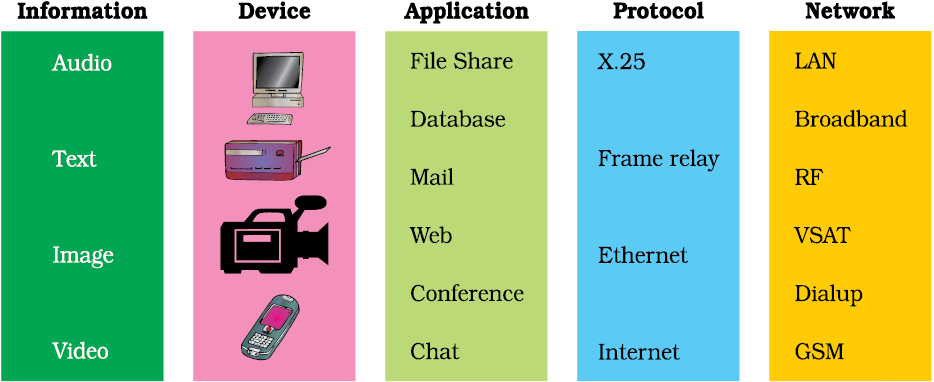
6.1.1 Message
The content that has to be such communicated as document, picture, song, etc. It can be in any form such as text, number, image, audio or video.
6.1.2 Sender
The sender can be any device such as a computer, mobile, telephone, video camera, etc. which is used to send the information.
6.1.3 Receiver
The receiver can be any device such as a computer, mobile, telephone, video camera, etc. A device that receives the information.
6.1.4 Transmission medium
It is the connectivity between the sender and receiver, through any medium such as twisted pair cable, fibre optic cable, coaxial cables or radio waves.
6.1.5 Protocol
Protocols are a set of rules that control the communication between the receiver and the sender. The communication software interfaces two connecting devices and controls the flow of data. For successful communication, both the devices must follow a common communication protocol.
6.2 Applications
These are the software or programs designed to fulfill the specific requirement of the user. Eg., Mozilla Browser, Outlook Express, etc.
Internet Service Provider (ISP) : Company that provides Internet services
6.3 Evolution of Communication Systems
The modern communication systems started developing only after the nineteenth century with the development of the electromagnetic telegraph system.
In the telephone system (Figure 6.4), a microphone is used to convert voice signals into electrical signals and transmit the same through a pair of copper wires over a long distance. At the remote end a speaker/earphone is used to convert electric signals back to voice. All the local exchanges are interconnected through Public Switched checked Telephone Network (PSTN) backbone. Over the years, the telecommunication system has also undergone tremendous up gradation. Today, they provide multi-functionality like FAX, SMS, television, Internet, data communication, etc.
Modern PSTN uses high speed backbones with various types of transmission media such as fibre optics and wireless. The major break through in telecommunication system came after the development of following technologies.
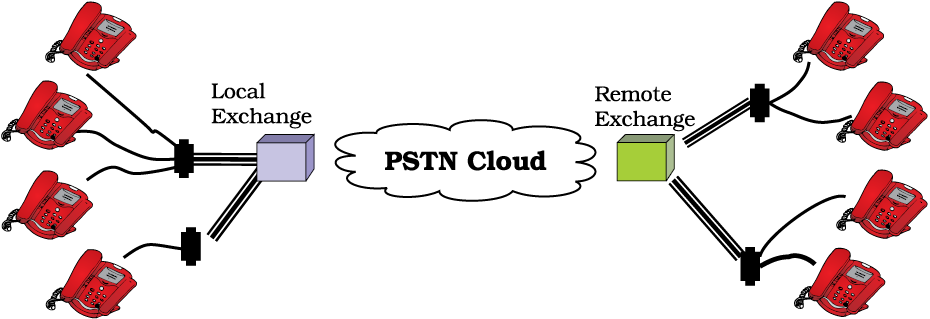
Figure 6.4 : Telephone system
1. Pulse Code Modulation: Technology for digitisation of voice/analogue signal into digital signals (Figure 6.5).
2. Multiplexing of multiple low speed signals into a high speed signal.

Figure 6.5 : Digitisation of information
3. Invention of various transmission media such as wireless, fibre optic cables, etc.
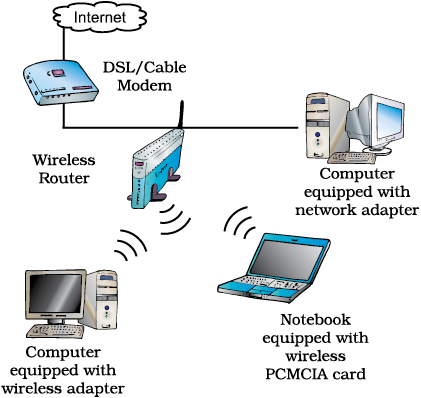
Wireless Network : Communication medium where devices are not connected through any cables, but through radio waves. Mostly used for connecting areas where the users are always mobile or it is not possible to lay cables.
Satellite network: Communication system where signals are transmitted directly to many points spread across a large region through satellite. It is being widely used for intercontinental/long distance communication for telecommunication and television broadcasting.
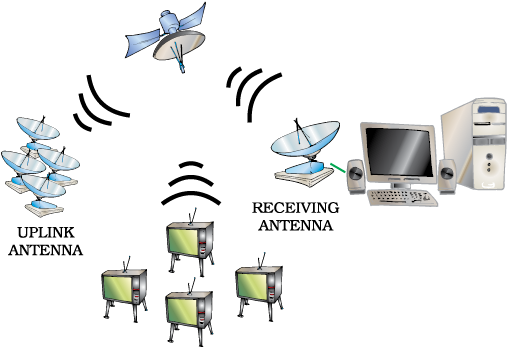
Television and radio connection through satellite
Earlier computers were directly connected to devices such as terminals, printers, monitors, etc. The distance between two devices was also limited within a room or a building. The data transfer was also restricted to sending small text messages and commands.

Figure 6.6 : Direct communication between two computers
Long distance data communication was done through low speed point to point connections (Figure 6.7) such as leased lines and dial-up.
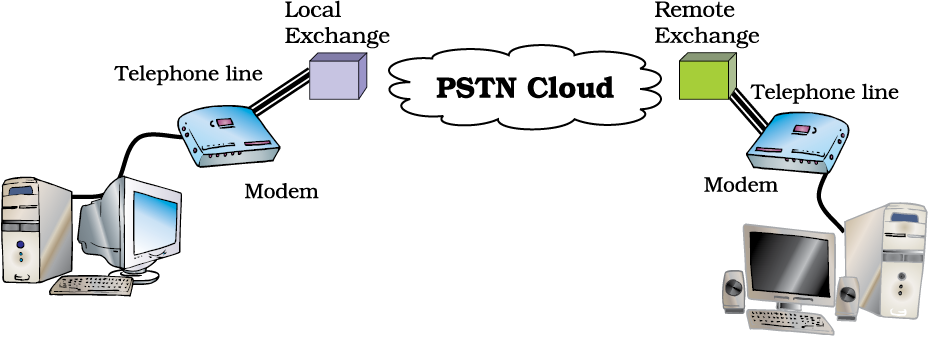
Figure 6. 7 : Long distance point to point connection through Modem
Leased lines and dialup connections use telecommunication infrastructure as their backbone. At both ends, an electronic device called a modem is used to terminate the connection. Modems modulate digital signals from computers into voice graded analogue signals, and then transmit these analogue signals through telephone lines. At the remote end, the analogue signals are demodulated into digital signals. In dialup and leased line connections, the telephone lines could either be used for data communication or for voice communication, but not simultaneously.
With telecom technologies such as ISDN and Broadband, the telephone connection can now be used simultaneously for voice communication as well as data connection (Figure 6.8).
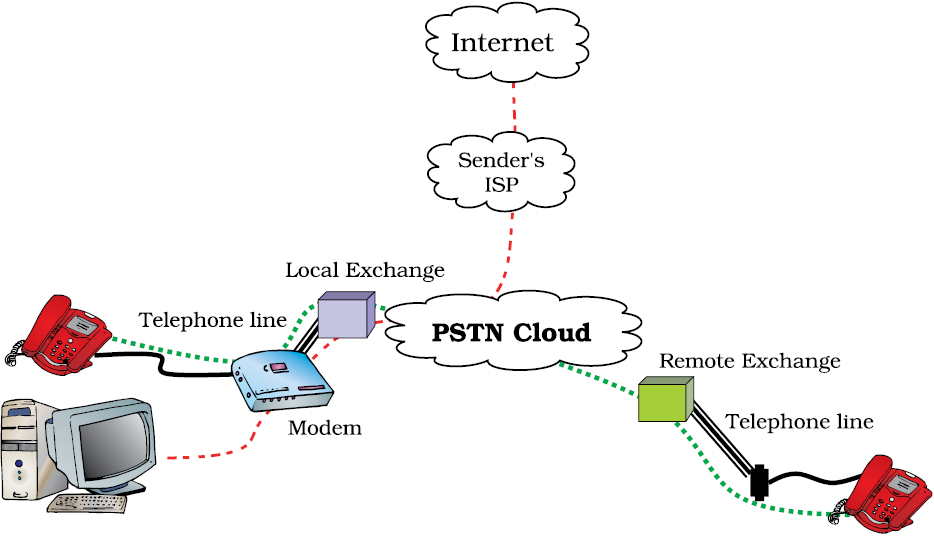
Figure 6.8 : Simultaneous voice and data communication through ISDN network
6.4 Convergence of Communication Technologies
Earlier, there were separate networks for voice, video and data communication. These networks did not meet the requirement of next generation integrated multimedia applications such as video conferencing, Net-meeting, etc. which require simultaneous transmission of voice, data and video. Efforts are made to develop integrated solution to support multimedia applications through a single communication system. As more and more tasks are becoming computer dependent, convergence of the technologies has become a necessity.
Objectives of convergence of communication technologies are –
(i) to provide cost effective communication system.
(ii) to make deployment easier and convenient.
(iii) to make optimum use of existing infrastructure to support multimedia applications.
(iv) to develop high availability and high speed network to support online interactive application such as telemedicine, video-conferencing.
(v) to provide inexpensive unified services.
The emergence of global competition is also driving the ISPs to provide unified services like email, talk, chat, web search, etc. from a single platform, using the existing infrastructure.The tele-communication service providers started giving additional services like Internet access, broadcast services like video-on-demand, IPTV, etc. Customers are also opting for such ISPs who can provide single point solution for all required services.
Data networks are now extensively used for telecommunication services such as Voice over Internet Protocol (VoIP) and broadcasting services like IPTV. Even the cable TV operators are providing Internet connection along with cable connection. Today mobile phones are equipped with Internet and FM radio services.
The equipment manufacturers are developing plug and play devices that can be connected with multiple networks and can be controlled from remote locations.
6.4.1 Developing Uniform Data Representation and Digitisation Technologies
Digitisation of data is the first step in the process of convergence. All types of data whether text, number, image, voice or video, can be represented in the binary form. Digitisation is the process to convert any type of data into binary digits that can be processed by any computing device.
The motivation behind this digitisation is the fact that the computer works on the principle of manipulation of numbers. If any data is in binary form, it can easily be manipulated by the computer. Therefore, efforts are on to develop technologies to digitise various types of data for better storage and transmission. Once digitised, irrespective of the type of data, the same communication system can be used for transmitting.
6.4.2 Convergence of Standards and Protocols
During communication, the message is processed at various stages by several intermediate hardware and software components. It is cost effective and easy to integrate if all the components follow uniform protocols and standards. There are some standards and protocols which have become very popular and have emerged as standards. These standards are followed by industries and manufacturers. Some such protocols are –
1. Internet Protocol (IP) is the most popular protocol to interconnect different networks.
2. Ethernet is most popular standard for Local Area Network.
3. HTTP is most popular protocol to connect web applications.
4. MPEG is compression technology for transmission of video.
The function of Internet Protocol is similar to our postal delivery system but is electronically processed and is very fast.
In the traditional postal system, the message, written in the form of a letter containing receiver’s and sender’s addresses, is dropped in the nearest letter box. Letters collected from all the letter boxes are segregated as per the state/city in the post office. All letters to the same city are bundled and sent through air/train depending upon the distance and availability. At the remote city, the letters are unbundled and sent to the respective local post offices. Finally the letter is delivered to its destination through the local postman.
Similarly in the Internet (Figure 6.9), all messages are sent in the form of packets called IP packets. Each packet is marked with source address and destination address. Like every person is identified with a name and address, each computer connected to the Internet is also identified with a unique address/name termed as IP address/domain name respectively. The computer sends the IP packet directly to the connected IP network. In the Internet the packets are forwarded from one network to other as per the destination address till it reaches the receiver.
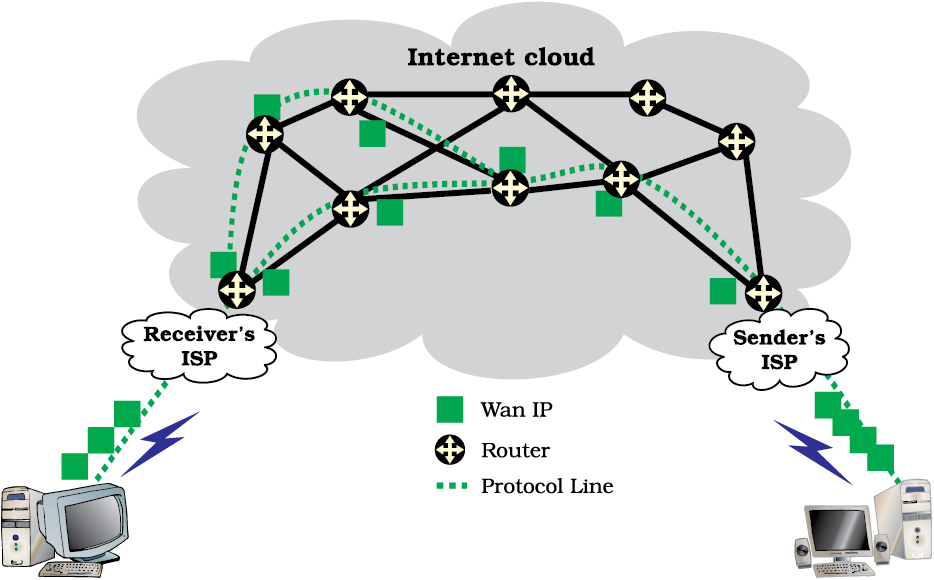
Figure 6.9 : Internet
Internet Protocol has become very popular as it can withstand and overcome the frequent breakdown of communication links. It was designed to automatically find an alternative path and continue the communication without any break.
Ethernet (Figure 6.10) is another communication protocol which has become very popular for connecting communication devices through various types of transmission media such as copper, wireless and optical fibre. It can support various data transfer rate as 10 Mbps/100 Mbps/1 Gbps/10 Gbps and is very simple to implement. Today all computer peripherals such as printer, scanner, etc. are equipped with Ethernet interface instead of serial/parallel interfaces.
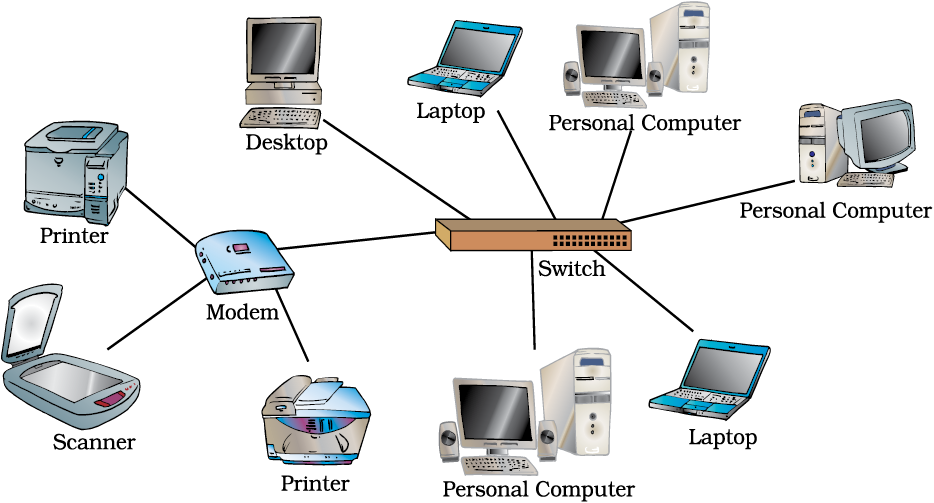
Figure 6.10 : Convergence of computer and other devices with Ethernet and IP
6.4.3 Convergence of Network
Broadband is one simple example of convergence of voice, video and data. Broadband is the latest communication technology using which a user can have simultaneous voice calls, Internet access and cable television over the same telephone line (Figure 6.11). Effort is being made to provide more high bandwidth services through various types of transmission media.
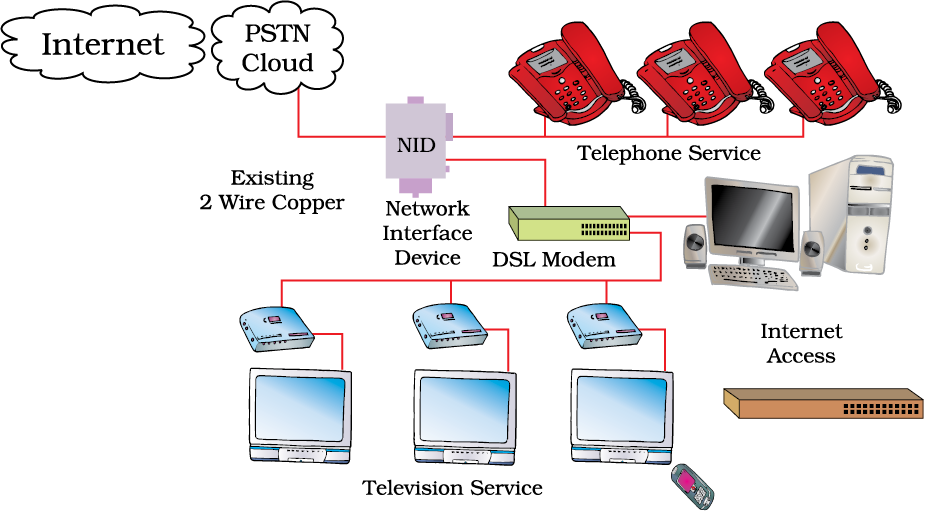
Figure 6.11 : Convergence of voice, video and data in broadband network
6.4.4 Convergence In Voice Communication
In this age of convergence, voice communication can be done from multiple networks with multiple connecting devices and from multiple locations (Figure 6.12). The mobile phone connected to wireless network can communicate with landline telephone connected to PSTN network as well as with multimedia computer connected with the Internet. Instant messages can be sent from a computer to a mobile phone.
Devices from one network can communicate with devices from other network through gateways. Gateways are communication devices used to interface different networks. Manufacturers are developing multipurpose plug and play devices which can be connected anywhere at any time.
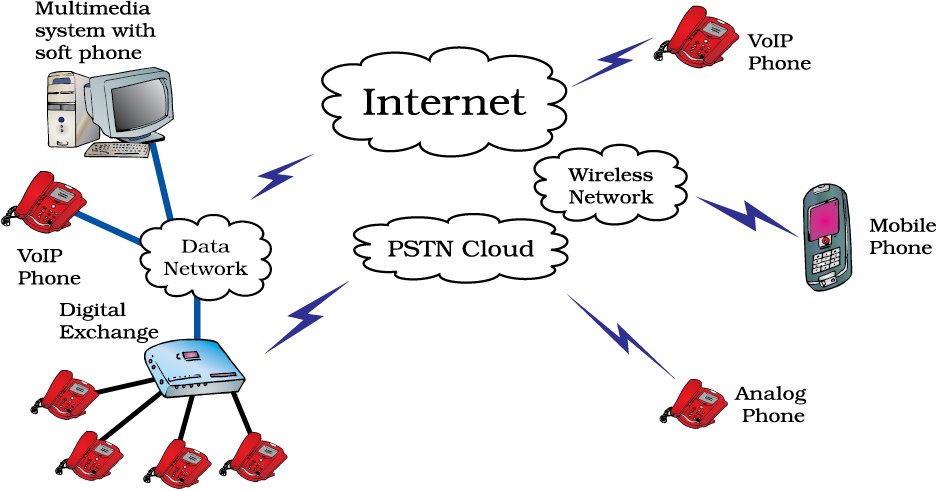
Figure 6.12 : Voice in converged network
6.4.5 Convergence of Video Communication
Video–conferencing and video–streaming (Figure 6.13 ) are some of the multimedia applications gaining popularity. Video-conferencing was primarily done through point-to-point connection like ISDN, leased line, etc. and required specialised equipment.
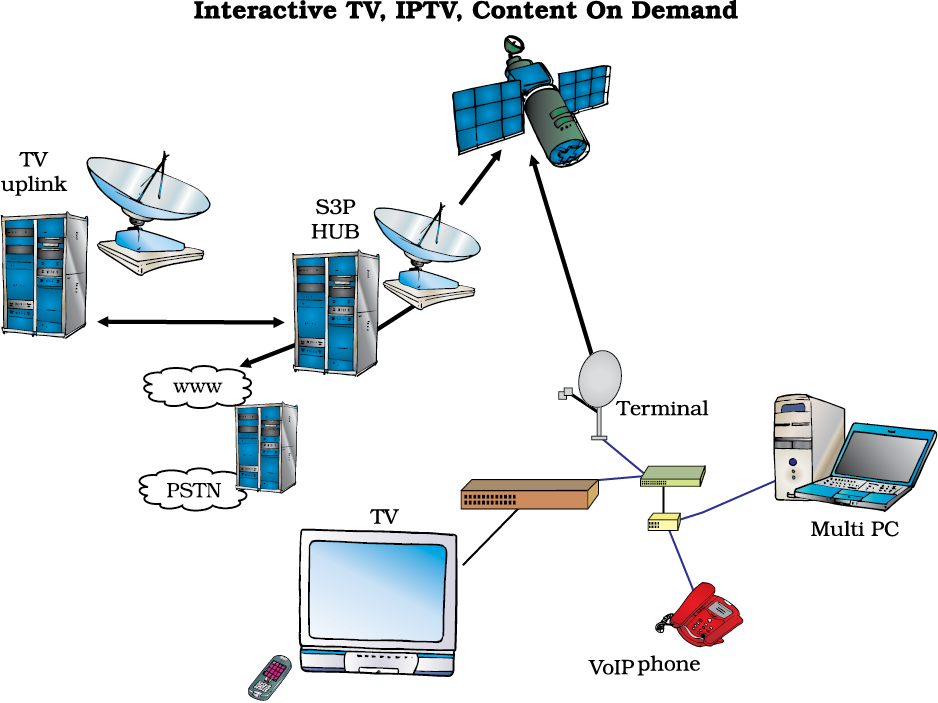
Figure 6.13 : Video streaming through IPTV
Today, thanks to convergence, video-conferencing is done through IP networks and does not require costly video conferencing systems; all that is required is a multimedia system with a camera and associated software.
High quality and reliable video-communication is possible with the development of features like Quality of Service (QoS) and video compression techniques such as MPEG.
The technology to prioritise IP packet containing voice and video traffic over other data packets is called Quality of Service.
Moving Pictures Expert Group (MPEG) algorithms compresses video data to reduce number of bytes that can be easily transmitted and then decompressed.
Since video traffic requires high bandwidth, it becomes difficult to get acceptable quality when transmitted through low speed PSTN or satellite links. These video signals are therefore compressed and formatted before transmission. Video compression techniques such as MPEG4 can compress video data upto 100 times which can then be transmitted through low speed networks.
Earlier news and movies were telecast through broadcast media using satellite, wireless and cable. The signal quality was noisy and non interactive. Now with technologies like IPTV and video-on-demand, high quality video can be received. IPTV is a broadcast service provided by telecom operators through their PSTN networks. The user can view the video telecast through their traditional TV sets as well as computer systems.
Video-on-demand is another video streaming service where the user has the option to select what s/he wants to watch from among those stored in the media server.
6.4.6 Convergence of Wireless Network
Wireless is one of the fastest growing networks. The demand is growing as more and more users require access to Internet from multiple locations. It is becoming as essential as mobile phones.
Wireless LAN, WiFi and WiMax are few such technologies which provide high speed data communication over wireless networks. Computer systems are designed with built-in wireless interface cards which can connect to any type of wireless networks. In wireless network, computers are connected to the nearest available access point.
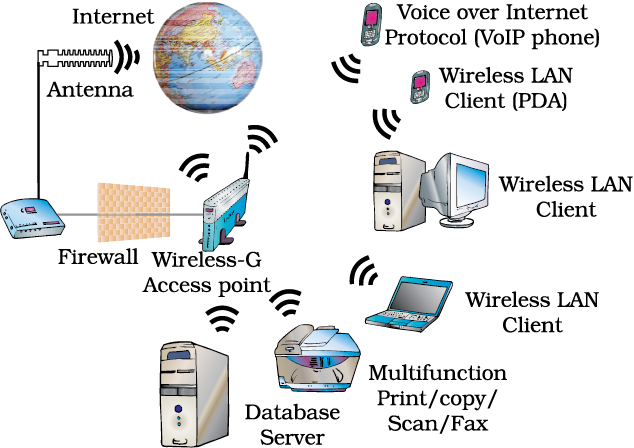
Figure 6.14 : Convergence of wireless
Access points are similar to the Ethernet device where all computers with wireless card can connect for data transmission.
The access points are connected to other networks through wired Ethernet connection or broadband connection.
With third generation mobile technology such as GPRS, one can use mobile devices to access multi-service applications like voice communication, Internet and video conferencing.
6.4.7 Convergence of Applications
Web browsers like Internet Explorer, Firefox, etc. are the accepted client applications for Internet access. Most equipment manufacturers are providing web interfaces for management and control of their systems instead of product specific client application.
Most of the applications are developed with web interface so that the application can be accessed from a standard client application supplied as part of the operating system.
Another example of convergence of application is unified messaging system. There are many popular web service providers, for instance Yahoo, MSN and Google, who started with either e-mail or search engines, but are now providing a banquet of messaging services like email, chat, instant messenger, conferencing, file sharing and VoIP.
There are several applications that can replace multiple communication devices such as telephone, fax, answering machine, books, etc, with one multimedia computer. The number of such services and applications are increasing day-by-day. Broadband and Direct-to-Home (DTH) are some communication technologies which allow interactive TV services such as movie-on-demand, Internet access, video conferencing and e-mail, all through a single connection.
In a nutshell, any data that can be digitised can also be communicated through a converged communication system. The distinct division between telecommunication and data communication has faded into one converged communication system. Efforts are on to make more and more services IP enabled and networked.
In the next chapter, we shall discuss various Internet applications used for communication.
6.5 Importance of Standardisation
Standardisation plays an important role in every sphere of our day-to- day life. Standardisation is the process of agreeing on technical specifics of any process or product.
The goals of standardisation are to have compatibility, interoperability, safety, repeatability and quality. In a competitive market, it is very important for industries to maintain the standards to flourish in their trade. There are predefined standards set for the IT industry too. This is to guarantee the interoperability and compatibility between products from different vendors. There are various standardisation organisations worldwide which are primarily engaged in the documentation, research, development, and testing in the field of computer hardware, software and communications to formulate standards. Once a standard is accepted, the vendors can design and develop the product as per the standards.
Some important standardisation organisations in the field of Information Technology are as follows –
- ANSI (American National Standards Institute)
- ITU (International Telecommunication Union)
- IETF (The Internet Engineering Task Force)
- IEEE (Institute of Electrical and Electronic Engineers)
- EIA/TIA (Electronic Industry Association/Telecommunication Association)
- ISO (International Standards Organisation)
- VESA (Video Electronics Standards Association).
The Internet Engineering Task Force (IETF) is a large open international community of network designers, operators, vendors, and researchers concerned with the evolution of the Internet architecture and the smooth operation of the Internet. While IEEE is generally concerned with hardware, ANSI has been primarily concerned with software. ANSI has defined standards for a number of programming languages including C, C++, COBOL and FORTRAN. All these organisations collectively provide the framework of the standards which bind IT across the world. They let us work easily across regions, without being bogged down with compatibility issues. For example, IEEE developed a set of network standards to facilitate interoperability among various make and models of network devices.
ITU defines international standards, particularly for communication protocols. It has defined a number of standards, including V.22, V.32, V.34 and V.42 that specify protocols for transmitting data over telephone lines.
EIA/TIA specifies generic telecommunication cabling system which supports multiproduct, multivendor environment. For example, EIA/TIA 568A and 568B standard is for the pin configuration of LAN cable.
Apart from these standardisation organisations, there are region specific associations of manufacturers who also contribute to the development of standards to meet the needs of that particular region.
In India there are few standardisation organisations like BIS (Bureau of Indian Standards), which actively participate in the development of standards in various fields.
Summary
- Telecommunication is the use of electronic system to send and receive voice, data and video messages.
- Broadly there are five components of communication system, namely information/message, device, application, protocol and network.
- Voice communication requires telephone instruments like telephone, mobile or VoIP phones for PSTN, wireless or data network.
- Data communication allows transfer of information and remote management of devices.
- Data communication is undertaken by directly connected computers, printers, etc. in a Local Area Network.
- Long distance data communication is done through point to point connections using PSTN or wireless networks.
- Broadcasting of audio and telecasting of video service such as radio and television is done through wireless links.
- Ethernet is the most popular LAN technology for data communication which provides communication speed up to 10Gbps.
- Internet Protocol (IP) connects the computer across similar or diverse networks.
- In IP, data packets are transmitted in packets containing unique IP addresses for the source and the destination.
- IP automatically routes the packet to its destination through any available path.
- Convergence of technologies is required to meet the next generation unified applications where all the three forms of data are required to be transmitted simultaneously.
- IP is internationally accepted protocol through which all different forms of data can be communicated.
- The approach to convergence is to make all components of communication systems IP enabled.
- While trying to achieve convergence, effort is on to use existing infrastructure with partial upgradation.
- Broadband and IPTV are two next generation technologies which use PSTN to provide unified services for voice, data and video.
- VoIP is a data communication technology which allows IP phones and computers to connect to telephones through PSTN and mobile networks.
- Unified messaging system is provided by web service providers which can be used to access multiple services like e-mail, chat, call and entertainment from a single computer system with Internet connection.
- Standardisation is very important for interoperability of various components in any system,
- There are organisations which develop standards, rules and specification for a product that the manufacturers have to meet.
Exercise
Short Answer Type Questions
1. What is coding?
2. Why is digitisation required?
3. What are the emerging technologies that support voice, data and video?
4. What are the services provided by a broadband connection?
5. Why are unified messaging services becoming popular?
6. Explain features of circuit switching technology.
7. What are the features of packet switch technology?
8. Explore the sites which provide unified messaging services.
9. Explore the easiest way of connecting computers in a LAB.
10. Explore the easiest and fastest way of connecting computers on a campus.
Long Answer Type Questions
1. Identify the five components of data communication when a file is printed.
2. Identify the type of interfaces that are available in the computer and printers in your school lab.
3. Find out the various services provided by your local service provider. And compare the charges against each service among the local ISPs.
4. Find out the various ways a home computer can be connected to the Internet.
5. Configure a broadband connection for data and voice communication.
6. Explore some traditional means of communication.
7. What are the benefits of standardisation?
8. Find the specification of your computer system.
9. Identify the components of data communication.
10. Identify the components of mass communication.
11. How is voice communication different from data communication?
12. Explain the benefits of digitisation of Audio and Video Signals.
13. How does long distance data communication work?
14. Why is it easies to setup Ethernet network than X.25?
15. What are the advantages of Internet Protocol?
16. What is convergence of communication technology?
17. What are the benefits of convergence of communication?
18. Explain the constraints in the convergence of communication.
19. What are the various approaches to meet the requirements of next generation application?
Multiple Choice Questions
1. The 1st modern telecommunication device was
(i) Telephone
(ii) Telegraph
(iii) Computer
(iv) Television
2. Set of rules that controls communication between two devices is called
(i) Network
(ii) Application
(iii) Protocol
(iv) Media
3. Example of packet switching technology
(i) Ethernet
(ii) X.25
(iii) Broadband
(iv) RS 232
4. Example of Frame switching technology
(i) Ethernet
(ii) X.25
(iii) Broadband
(iv) RS 232
5. Circuit switching network is
(i) Point to point
(ii) Multipoint
(iii) Connectionless
(iv) Virtual connection
6. ISDN is telecommunication technology where
(i) Simultaneous voice and Data
(ii) Only Voice
(iii) Only data
(iv) Only Video
7. Internet Protocol ( IP) is
(i) circuit switching
(ii) packet switching
(iii) frame switching
(iv) point to point
8. Broadband is a convergence technology for
(i) Voice, data and video
(ii) Only data
(iii) Only voice
(iv) Only video
9. VoIP technology enables to connect
(i) Only PSTN telephones
(ii) Only Mobile telephones
(iii) Only VoIP telephone
(iv) All IP enabled telephone systems connected to the Internet.
10. GPRS is used in mobile phones for
(i) Data communication
(ii) Voice communication
(iii) Send SMS
(iv) None of the above
Activities
1. Identify the five components of data communication when a file is printed.
2. Identify the type of interfaces that are available in the computer and printers in your school lab.
3. Find out the various services provided by your local service provider. And compare the charges against each service among the local ISPs.
4. Find out the various ways in which a home computer can be connected to the Internet.
5. Configure a broadband connection for data and voice communication.
6. Find the model of the mobile phone available in your locality which supports voice as well as Internet.
7. Explore the sites which provide unified messaging services.
8. Explore the most easiest way of connecting computer in a LAB.
9. Explore the easiest and fastest way of connecting computers on a campus.